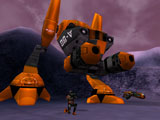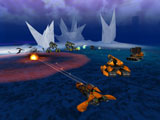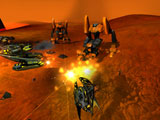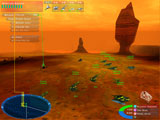 Activision’s
Battlezone was a great game; it came out of nowhere as one of the first strategy/action
hybrid games, had a catchy Cold War conspiracy plot, sported graphics that looked awesome
on first generation 3D cards, and offered excellent single-player and online gameplay. But for some bizarre reason, it didn’t sell
all that well, and has since become a fixture on every “best games you never
played” list. Battlezone II: Combat Commander is Activision’s attempt to update
the original, and while it’s a much prettier and more streamlined game, it also has
some serious problems, and quite frankly is not nearly as good as Battlezone. The great
irony of this is that it’s almost certain to outsell it. Battlezone II is one of those games that somehow manages
to be much less than the sum of its parts. While it has top-drawer graphics, a pretty
interesting plot, fast action and lots of options, each of these areas also has significant faults, and the game never seems to gel. Add to this
some serious crash bugs and very weak multiplayer, and a game that has the potential to be
a classic pretty quickly sinks to the “eh” level. Activision’s
Battlezone was a great game; it came out of nowhere as one of the first strategy/action
hybrid games, had a catchy Cold War conspiracy plot, sported graphics that looked awesome
on first generation 3D cards, and offered excellent single-player and online gameplay. But for some bizarre reason, it didn’t sell
all that well, and has since become a fixture on every “best games you never
played” list. Battlezone II: Combat Commander is Activision’s attempt to update
the original, and while it’s a much prettier and more streamlined game, it also has
some serious problems, and quite frankly is not nearly as good as Battlezone. The great
irony of this is that it’s almost certain to outsell it. Battlezone II is one of those games that somehow manages
to be much less than the sum of its parts. While it has top-drawer graphics, a pretty
interesting plot, fast action and lots of options, each of these areas also has significant faults, and the game never seems to gel. Add to this
some serious crash bugs and very weak multiplayer, and a game that has the potential to be
a classic pretty quickly sinks to the “eh” level.
 My love/hate relationship
with Battlezone II began as soon as I fired the game up; while I was stunned by the
game’s beauty—it’s hands down one of the prettiest games ever made—I
was also stunned by the clunkiness of the code. Battlezone II is a graphic delight; the
ISDF and Scion units look terrific, and the landscape you’ll fight over—from
snow to jungle to lava planets—is both interactive and gorgeous. But it takes a big
monkey to run this game—probably more than it should. Even with a PIII 450 and a TNT
2, I couldn’t run it smoothly at a higher 800x600 without switching off some of the
graphics options. And don’t get me started on load times, which can get very tedious,
especially since many of the missions are puzzle-oriented and entail a lot of
save-and-restart. I also had a hell of a time configuring my joystick; though I finally
figured it out, the manual was no help at all, and I eventually just switched to the
mouse-and-keyboard configuration the game almost seems to demand. This configuration is
the best way to play the game, especially given the number of keyboard commands
you’ll need to access while ordering about other units. The odd thing about it is
that you’ll soon discover that the best combat tactic is the tried-and-true circle
strafe. It seemed odd to play a game that’s ostensibly about tank combat (no matter
how futuristic) in this manner. The original seemed to offer more tactical subtlety; in
Battlezone II, you can work through most tactical situations pretty much same way you do
in Quake III. So I’m fifteen minutes into the game, and already I’m frustrated
and puzzled. My love/hate relationship
with Battlezone II began as soon as I fired the game up; while I was stunned by the
game’s beauty—it’s hands down one of the prettiest games ever made—I
was also stunned by the clunkiness of the code. Battlezone II is a graphic delight; the
ISDF and Scion units look terrific, and the landscape you’ll fight over—from
snow to jungle to lava planets—is both interactive and gorgeous. But it takes a big
monkey to run this game—probably more than it should. Even with a PIII 450 and a TNT
2, I couldn’t run it smoothly at a higher 800x600 without switching off some of the
graphics options. And don’t get me started on load times, which can get very tedious,
especially since many of the missions are puzzle-oriented and entail a lot of
save-and-restart. I also had a hell of a time configuring my joystick; though I finally
figured it out, the manual was no help at all, and I eventually just switched to the
mouse-and-keyboard configuration the game almost seems to demand. This configuration is
the best way to play the game, especially given the number of keyboard commands
you’ll need to access while ordering about other units. The odd thing about it is
that you’ll soon discover that the best combat tactic is the tried-and-true circle
strafe. It seemed odd to play a game that’s ostensibly about tank combat (no matter
how futuristic) in this manner. The original seemed to offer more tactical subtlety; in
Battlezone II, you can work through most tactical situations pretty much same way you do
in Quake III. So I’m fifteen minutes into the game, and already I’m frustrated
and puzzled.
 Since Battlezone II doesn’t have a tutorial and the manual
is borderline useless, you’ll learn most of what you need to know about the game by
playing through the single-player missions. At least initially, they guide you through a
pretty complex narrative. The Cold War is over, and the pesky Russkies of Battlezone are
now your allies. But no sooner is peace
established than an alien race, the Scions, begin to threaten the solar system.
You’ll soon find yourself fighting the Scion threat on distant planets, and soon
after that find yourself entangled in a Byzantine plot that will force you to make tough
decisions about whose side you’re really on. While the story’s pretty good, the
missions themselves are definitely a mixed bag. The early missions do a good job of
getting you started, but as they become more complex, you’ll sometimes feel like you
don’t quite know what’s expected of you. Even worse, sometimes you’ll know
exactly what’s expected of you--but you won’t know exactly how to do it.
Sometimes you’ll fail a mission over and over until you finally figure out the
counter-intuitive secret (blow up your own gun tower, or lead the snow rhinos onto the ice
until they crash through) that allows you to move on. If I’m the only one who
finds puzzle-oriented missions in a strategy game tiresome, excuse me, but if I’d
wanted to play Myst, I’d have bought Myst. Since Battlezone II doesn’t have a tutorial and the manual
is borderline useless, you’ll learn most of what you need to know about the game by
playing through the single-player missions. At least initially, they guide you through a
pretty complex narrative. The Cold War is over, and the pesky Russkies of Battlezone are
now your allies. But no sooner is peace
established than an alien race, the Scions, begin to threaten the solar system.
You’ll soon find yourself fighting the Scion threat on distant planets, and soon
after that find yourself entangled in a Byzantine plot that will force you to make tough
decisions about whose side you’re really on. While the story’s pretty good, the
missions themselves are definitely a mixed bag. The early missions do a good job of
getting you started, but as they become more complex, you’ll sometimes feel like you
don’t quite know what’s expected of you. Even worse, sometimes you’ll know
exactly what’s expected of you--but you won’t know exactly how to do it.
Sometimes you’ll fail a mission over and over until you finally figure out the
counter-intuitive secret (blow up your own gun tower, or lead the snow rhinos onto the ice
until they crash through) that allows you to move on. If I’m the only one who
finds puzzle-oriented missions in a strategy game tiresome, excuse me, but if I’d
wanted to play Myst, I’d have bought Myst.
 The game becomes more
interesting (but also more problematic) when you start getting into some serious
base-building. If you leave your tank and hop into a satellite relay station, you can
control the base and your units from an absolutely breath-taking overhead map view. The
first couple of base-building missions, I spent practically no time in my tank. I just
moved my units around from overhead. It was like playing 3D Starcraft. But while it looks
better than Starcraft, you quickly discover that it lacks Starcraft’s depth.
For example, if you manage to get some of the vastly overpowered gun towers up, your base
is secure. And frankly, the command view can be risky; the friendly AI is pretty awful,
and leaving your troops on their own is downright suicidal. While you can command your
units about from an elegant interface, they never seem to do quite what you want them to,
and the frustration mounts rapidly. Units often sit around obliviously while enemy tanks
bombard them, and if they do attack they tend to do so indiscriminately, firing away at
fairly innocuous enemies while worthier targets blow them away. Pathfinding is also subpar; if the path you want
your unit to take is in the least complicated, you’re going to have to babysit it. In
other words, if you want something significant done, you usually have to do it yourself.
This can be really annoying when you’re about to lead a painstakingly-planned attack
on an enemy base, only to find that the units you left to defend your biometal deposits
have let an enemy mortar them to bits while doing nothing in response. Argh. The game becomes more
interesting (but also more problematic) when you start getting into some serious
base-building. If you leave your tank and hop into a satellite relay station, you can
control the base and your units from an absolutely breath-taking overhead map view. The
first couple of base-building missions, I spent practically no time in my tank. I just
moved my units around from overhead. It was like playing 3D Starcraft. But while it looks
better than Starcraft, you quickly discover that it lacks Starcraft’s depth.
For example, if you manage to get some of the vastly overpowered gun towers up, your base
is secure. And frankly, the command view can be risky; the friendly AI is pretty awful,
and leaving your troops on their own is downright suicidal. While you can command your
units about from an elegant interface, they never seem to do quite what you want them to,
and the frustration mounts rapidly. Units often sit around obliviously while enemy tanks
bombard them, and if they do attack they tend to do so indiscriminately, firing away at
fairly innocuous enemies while worthier targets blow them away. Pathfinding is also subpar; if the path you want
your unit to take is in the least complicated, you’re going to have to babysit it. In
other words, if you want something significant done, you usually have to do it yourself.
This can be really annoying when you’re about to lead a painstakingly-planned attack
on an enemy base, only to find that the units you left to defend your biometal deposits
have let an enemy mortar them to bits while doing nothing in response. Argh.
 To make matters worse, the game is
buggy; though I’d heard plenty of complaints about bugs, I didn’t run into any
myself until well into the game, when during a particularly long and hard-fought mission I
found I could no longer issue commands to my units. Since I hadn’t saved in a while,
I had to start over, only to have the same thing happen. Grrr. To make matters worse, the game is
buggy; though I’d heard plenty of complaints about bugs, I didn’t run into any
myself until well into the game, when during a particularly long and hard-fought mission I
found I could no longer issue commands to my units. Since I hadn’t saved in a while,
I had to start over, only to have the same thing happen. Grrr.
And online play is definitely
substandard. Pandemic has already issued a patch for multiplayer, but out of the box
Battlezone II is a broken online game. I got better online gameplay out of the original
Battlezone with my 56.6 modem than I do with Battlezone II on my DSL; that’s a
problem.
Frankly, I get the feeling that
Battlezone II was rushed out before it was ready. All the signs are there—bugs,
unfinished multiplayer game, high system demands, weak manual, pathetic AI. None of these
problems are insurmountable, and it looks like Pandemic is willing to crank out the
patches that might make this game the show-stopper it should have been. It’s too bad
that Activision didn’t take the time to finish this game; there were moments while
playing that I found myself immersed in the narrative, enthralled by the graphics, and
enjoying the gameplay. But these moments never lasted long enough; some frustration large
or small always managed to break the spell. I’m afraid many gamers will have
the same experience and wonder what all the fuss was about the original Battlezone. It
deserves better.
--Rick
Fehrenbacher |

 Activision’s
Battlezone was a great game; it came out of nowhere as one of the first strategy/action
hybrid games, had a catchy Cold War conspiracy plot, sported graphics that looked awesome
on first generation 3D cards, and offered excellent single-player and online gameplay. But for some bizarre reason, it didn’t sell
all that well, and has since become a fixture on every “best games you never
played” list. Battlezone II: Combat Commander is Activision’s attempt to update
the original, and while it’s a much prettier and more streamlined game, it also has
some serious problems, and quite frankly is not nearly as good as Battlezone. The great
irony of this is that it’s almost certain to outsell it.
Activision’s
Battlezone was a great game; it came out of nowhere as one of the first strategy/action
hybrid games, had a catchy Cold War conspiracy plot, sported graphics that looked awesome
on first generation 3D cards, and offered excellent single-player and online gameplay. But for some bizarre reason, it didn’t sell
all that well, and has since become a fixture on every “best games you never
played” list. Battlezone II: Combat Commander is Activision’s attempt to update
the original, and while it’s a much prettier and more streamlined game, it also has
some serious problems, and quite frankly is not nearly as good as Battlezone. The great
irony of this is that it’s almost certain to outsell it.